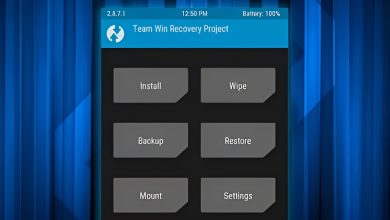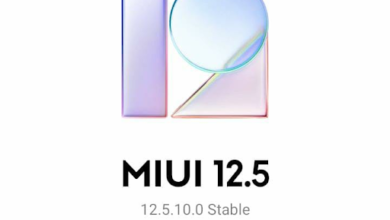How to Install Lineage OS on an Android Phone?
Lineage OS project is developed by volunteers for specific devices by using Gerrit for its code review. Lineage OS with its own versioning also uses Android versioning like Lineage OS 14.1 is Android 7.1. In starting, there were some unofficial versions of Lineage OS but now, all the released versions are signed with the private keys of the Lineage OS, so we can say that using Lineage OS is a safe bet.

The devices running Lineage OS now receive weekly OTA updates whereas, in the start, it was set on nightly updates. The Lineage OS supports upgrades to older devices where the OEM has stopped the official support for those devices. The latest LineageOS version is 19 with Android version 12.1 Snow Cone.
Warning and Backup
You may flash Lineage OS on a device or a phone at your own risk. Even if you follow this article to the letter, we can’t guarantee that your device will not break and we do not take any responsibility if your device or phone breaks or is bricked.
This article is for educational purposes only and we have tried our best to include the best/safest methods for the installation process but we cannot offer any type of guarantee of success. Also, flashing Lineage OS on a device or phone may void the phone’s warranty, so, advance at your own risk as Appuals.com will not be responsible for any issues during or after flashing Lineage OS on your device or phone.
Moreover, installing or flashing Lineage OS on your device will wipe all the data on your phone, so, make sure to back up the phone’s data. Additionally, if you want to play safe, you can back up the phone’s stock ROM (the Internet is your best friend) to reflash it later if the Lineage OS did not meet your requirements.
Requirements to Install Lineage OS
There are some requirements to complete the installation of the Lineage OS on your phone or device:
- A Lineage OS Compatible Android Device and do not forget to fully charge your device as you may brick the phone if it gets out of charge during the flashing process.
- A Compatible USB Data Cable (preferably, by the phone’s OEM). Do not fall for cheap USB cables as these cables can prove costly if the phone is bricked during the installation process.
- A Windows, Linux, or Mac PC (in some cases, a system with ChromeOS).
- An Active Internet Connection to Download Packages and Software Applications.
- Time as the flashing process may take an hour or two, depending on your technical knowledge and the speed of the Internet connection.
Step 1: Check Your Device Compatibility
Enough of theory, let us move to flash Lineage OS on your device. The first step should be to check if your device is compatible with the Lineage OS and if your device’s custom ROM based on the Lineage OS is available.
- Launch a web browser and navigate to the downloads page of the Lineage website.
- Now, in the left pane, select the manufacturer of your device (like Samsung) and then select your device’s model (like Samsung S10).

Check Device Compatibility on the Lineage Website
If your device is not shown on the downloads page of the Lineage website, then sorry to say you cannot install Lineage OS on your device (although you can use unofficial versions of the Lineage OS, we strongly recommend against them) and you may try another Android distro.
Step 2: Set Up PC and Device for Flashing
So, let us set up the PC and device for flashing.
Download and Install ADB with Fastboot
- Download and install ADB on your PC. Make sure to enable Fastboot and note down the path to the ADB/Fastboot files. Do not forget to install Platform Tools as well.
Download TWRP (Team Win Recovery Project)
- Launch a web browser and head to the TWRP website.
- Now head to Devices and search for your mobile phone. Make sure to select the correct version of the TWRP as per your mobile phone.

Download TWRP Recovery as Per Your Android Device - Then steer to the download section and select the recovery software as per your region.

Download TWRP Version as Per Your Region - Now download the TWRP recovery.
Download the Lineage OS
- Head to the downloads page of the Lineage OS and select your OEM.
- Now select your mobile phone and download the Lineage OS. Make sure to note down the Lineage OS version as you may require it when downloading Google Apps.

Download the Latest Lineage OS as Per Your Mobile
Download Google Apps (Optional Download)
To use your phone with your Google account, you will need to access the Play Store and all other Google features but that is not natively available on the Lineage OS (being an open source project). For that, you may install Google Apps. If you have planned not to use any Google-based Android features, then you can skip Google Apps.
- Launch a web browser and steer to the GAPPS download page of the Lineage website.
- Now open the GAPPS link as per the downloaded Lineage OS in the previous step.
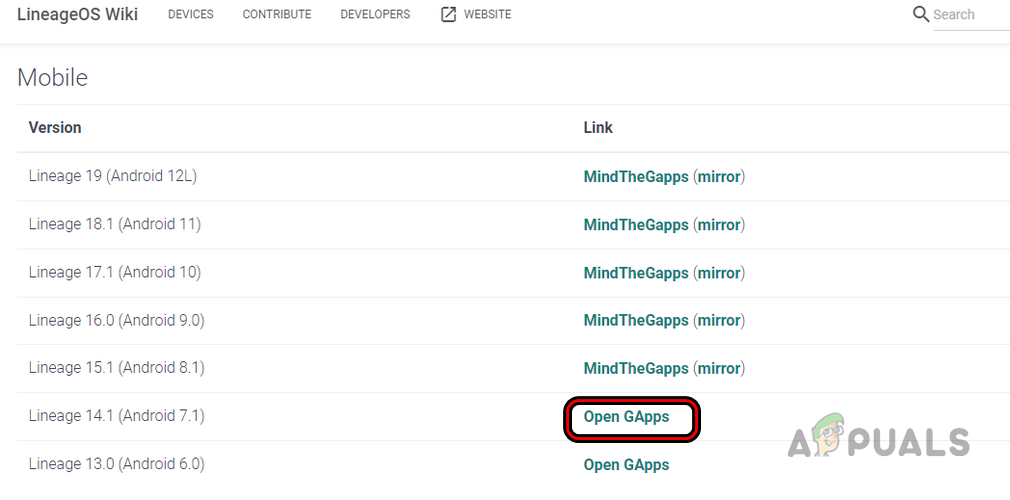
Open GApps Link as Per the Required Android Version - Then select the platform (if you are not sure about the processor type of your device, search the Internet), and afterward, leave the Android version to the pre-selected.

Download GApps as Per Your Mobile Phone Specs - Now choose the variant. Nano is the one with fewer options whereas Full contains all the GAPPS features. If you are not willing to use Full, then you may opt for Micro or Larger.
- Then click on the download button and wait till the download completes.
Download SU (Optional Download)
If you want to enable root access on your device after flashing Lineage OS on the device, then you may download SU. If you are not willing to enable root access on the phone, then you can skip the SU download. For some models, you may have to use the Magisk app to enable root access.
- Launch a web browser and head to the Extras section of the Downloads page of the Lineage website.
- Now download the SU as per your phone’s architecture (like X86).

Download SU From the Lineage Website
Then move all these downloaded packages to the ADB folder, usually, the following location on a Windows PC:
%USERPROFILE%\adb-fastboot\platform-tools
Enable Developer Mode and USB Debugging on Your Phone
To flash the Lineage OS on a phone, we need developer access and USB debugging on the phone as these features are essential to enable write access to the system ROM.
- Enable Developer Mode and USB Debugging on your Android phone.

Enable USB Debugging in the Developer Options of the Android Phone
Step 3: Unlock the Bootloader of Your Phone
The first practical step in flashing Lineage OS on your Android phone is to unlock your phone’s bootloader. If you still have not backed up the phone, then make sure to back up your phone’s data as it will be wiped in the coming steps. Also, not every OEM permits unlocking on its bootloader, so, you may have to dig deeper by searching the forums on the Internet to unlock the bootloader of your particular device.
- Connect your phone to the PC with a USB data cable and on your phone (if asked to), make sure to select that you trust the system. Then launch the system’s File Explorer.
- Now navigate to the folder where your ADB and Fastboot files are stored, usually, the following:
%USERPROFILE%\adb-fastboot\platform-tools
- Then hold the Shift key and right-click in the folder.
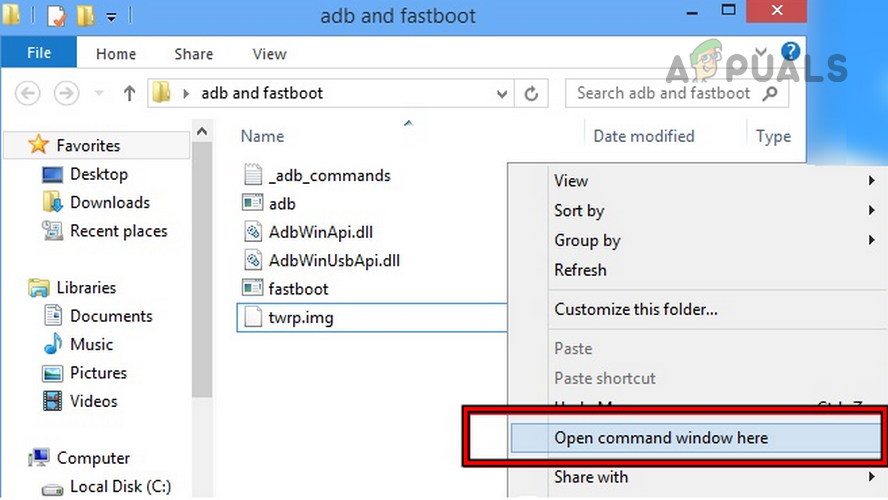
Open Command Windows Here - Now select Open PowerShell Window Here or Open Command Prompt Window Here and then execute the following:
adb devices

Execute the ADB Devices Command to Check if the Android Device is Connected With the Phone - Then check if your phone is shown on the devices’ list. You may have to tap on OK on your phone’s screen (make sure to checkmark the Always Allow option) to enable ADB communications for the first time and re-execute the above command. If your phone is not shown in the devices, then reconnect the phone to the PC on a different USB port and repeat the above steps. In some cases, you may even have to install or update your phone’s drivers on the PC.
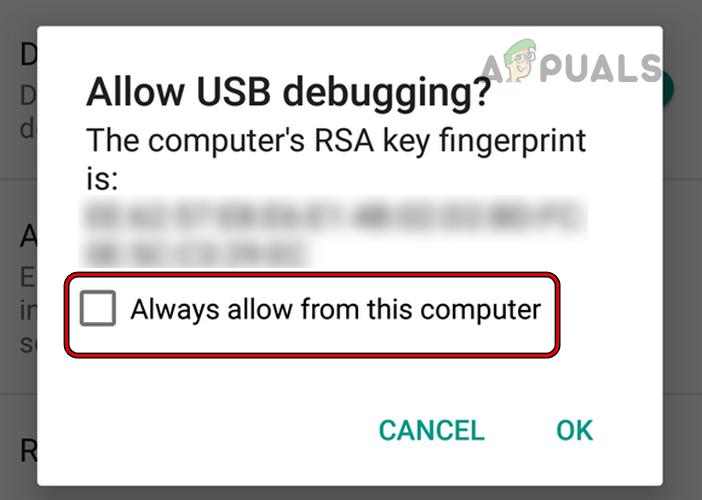
Select Always Allow from This Computer the USB Debugging Dialogue Box - Once your phone is shown in the devices after executing the PowerShell command, execute the following:
adb reboot bootloader
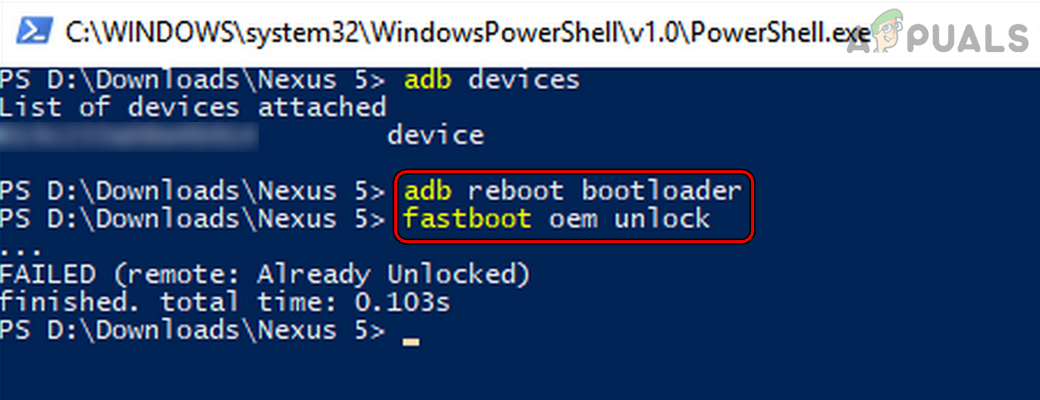
Unlock the Android Phone’s Bootloader - Now wait till the phone restarts in the bootloader and then execute the following command to unlock the bootloader (your phone will revert to the factory settings, so, make sure the data on the phone is backed up):
fastboot oem unlock
- Then, on the phone’s screen, use the volume up or down buttons to select Yes and press the power button to confirm unlocking of the bootloader.
If you fail to unlock your phone’s bootloader as your OEM does not support the ADB command to unlock the phone’s bootloader, then you may search the Internet to find out the method to unlock your phone’s bootloader.
Step 4: Flash TWRP on Your Phone
After unlocking your phone’s bootloader, it is time to flash a custom recovery (like TWRP) on your phone. If you are not comfortable with the TWRP recovery, you can also use the recovery image from your phone’s download page on the Lineage website or you may use Clock Work Mode Recovery.
- Once your phone resets to the factory defaults after unlocking the bootloader, then launch the system’s File Explorer and steer to the folder where TWRP files are stored.
- Now hold the Shift key and right-click on the TWRP folder.
- Then select Open PowerShell Window Here and afterward, execute the following:
fastboot flash recovery <nameofrecovery.img>
- Make sure to replace the nameofrecovery.img with the actual name of the recovery file e.g., if the name of the recovery file is twrp-3.2.1-1-hammerhead.img, then the command will be as under:
fastboot flash recovery twrp-3.2.1-1-hammerhead.img

Flash TWRP Recovery on the Android Phone - If you are having issues in flashing recovery, you may (one by one) execute the following (do not forget to change the Recovery.img with the actual file name):
fastboot devices fastboot flash recovery RECOVERY.img
Step 5: Wipe/Reset Partitions on the Phone
Now is the time to wipe the official Android from your phone. To do so:
- Power on your phone and use the volume buttons (in some models, you may also need to press/hold the power button as well) on the phone to boot into the phone’s recently flashed recovery mode.
- Now, in the recovery screen tap on Wipe and then open Advanced Wipe.

Open Advanced Wipe in the TWRP Recovery - Then checkmark the options of System, Data, and Cache. Do not select any other boxes.
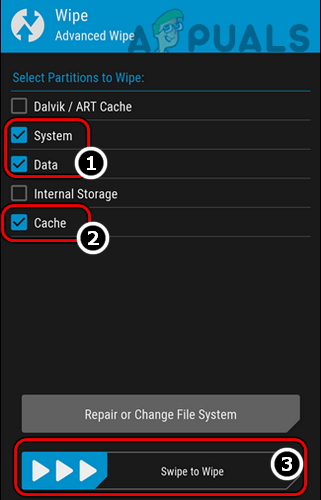
Swipe to Wipe System, Data, and Cache Through the TWRP Recovery - Now swipe the bottom bar to the right to start the wipe process and wait till the process completes.
- Once done, restart your phone by using the button on the bottom.
If you are using Lineage OS recovery (not TWRP recovery), then you may execute the following one by one:
fastboot reboot adb reboot recovery
Step 6: Flash Lineage, GAPPS, and SU on the Phone
Now we will perform the main task of installing or flashing Lineage OS on your phone.
- Launch the system’s File Explorer and head to the folder where Lineage, GAPPS, and SU are present.
- Now hold the Shift key and right-click in the folder.
- Then select Open PowerShell Window Here and execute the following (here, the SD card is the local storage of the phone, and no need to insert an SD card in the phone. Also make sure to replace nameoflineagebuild.zip with the original file name):
adb push <nameoflineagebuild.zip> /sdcard

ADB Push Lineage to the Android Phone - Now move the GAPPS and SU (if you are willing to install these) to the phone by executing the following (make sure to replace the GAPPS.zip and SU.zip with the original file names):
adb push <gapps.zip> /sdcard adb push <su.zip> /sdcard
- Then, boot your phone in the recovery mode, tap on Install and select the Lineage OS zip. Make sure the Lineage OS is the first file in the queue.
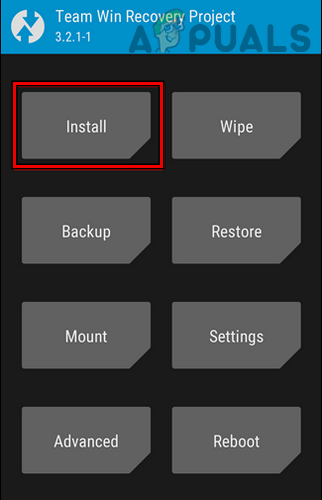
Tap on Install in the TWRP Recovery - Now tap on Add More Zips and select the GAPPS zip. If you think that you may install the GAPPS later, then you will have to redo all the above processes, so, make the choice accordingly.
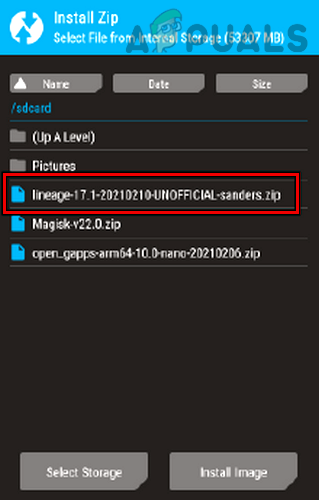
Select the Lineage ZIP in the TWRP Recovery - Again, tap on Add More Zips and select the SU zip.
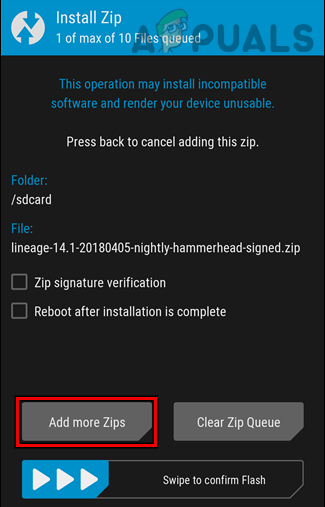
Tap on Add More ZIPS in the TWRP Recovery - Now make sure the top bar says “3 of Max of 10 Files Queued“.

Swipe to Confirm Flashing Lineage OS on Your Android Phone - Then swipe the bottom bar to confirm the flashing of Lineage OS on your phone and wait till the process completes.
In the case of non-TWRP recovery, you may (one by one) execute the following in the system’s PowerShell in the ADB folder (do not forget to replace files with the original file names):
adb sideload LINEAGE.zip adb sideload GAPPS.zip adb sideload SU.zip
Step 7: Boot and Set Up Your Phone
Once the flashing process completes, reboot your phone for the last time and wait till the phone reboots as it can take some time to boot for the first time after flashing Lineage (if it takes more than 15 minutes, then you may force restart the phone). Once done, set up your phone as per your liking, and hurray, you are running Lineage OS on your phone. To enable root access, head to the Developer Options of the Lineage OS and enable it there.
If you are not happy with the Lineage OS on your phone, then you can reflash your phone with the stock ROM (the process is generally the same as the above) but you may need to search the Internet to do so. We are hopeful that this article will be helpful for you in the world of flashing custom ROMs but if you have any queries, we will be very happy to help out in the comments section.

